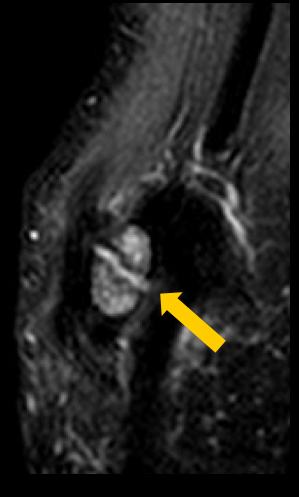The plantar plate of the first MTPJ lies on the plantar aspect of the joint between the two sesamoids. It separates the head of the metatarsal from the first flexor tendon and is equivalent to the volar plate in the fingers. The plantar plate of the other MTPJ's is a similar structure. It has two bands, medial and lateral, with a recess between them. Plantar plate injury or insufficiency may be the result of wearing high-heeled shoes, hypermobility, acute hyperextension trauma or overuse.
The typical clinical finding his pain and, if tolerated, and increased range of movement.
Running and push-off is usually compromised. In the long term, the injury may result in hallux rigidus and hallux valgus.
The second MTPJ is most commonly involve but turf toe describes an acute hyperextension injury of the first MTPJ. So called because most are associated with playing sports on a hard surface such as artificial turf.
The injury is thought to be a combination of extension at the joint followed by impaction which leads to hyper extension and plate disruption.
The tear occurs close to the distal insertion onto the base of the proximal phalanx and mainly affects the lateral band.
The diagnosis can be made by either MRI or ultrasound which allows visualisation of the plantar plate and in particular its relationships to the proximal phalanx
Tears manifest as discontinuity of the plate or altered echogenicity most commonly at the distal attachment of the lateral band to the base of the 2nd proximal phalanx. There may be associated entheseal changes, flexor tendon subluxation, joint effusion and synovitis. With full thickness tears, fluid may traverse the tear to enter the flexor sheath. If due to acute hyperextension injury (turf toe) bone oedema may be seen in the metatarsal head and proximal phalanx due the impaction injury
Pericapsular fibrosis can be associated and needs to be differentiated from Morton's neuroma.
Spectrum of conditions including
• stress fractures
• osteochondritis
• chondromalacia
• avascular necrosis
Caused by repeated forefoot loading such as dancing and running.
The onset may be acute or develop insidiously.
Patients complain of pain beneath the first MTPJ, with restricted movement of the joint.
The medial sesamoid and bipartite sesamoids are more commonly affected.
Plain radiographs may show sclerosis or fragmentation of the sesamoids.
In nearly all cases of ‘sesamoiditis’ the sesamoid bone is bi- or multi-partite.
On MRI there may be bony fragmentation with bone oedema on fluid sensitive sequences.
If there is avascular necrosis the affected sesamoid is of low signal on all sequences.
Ultrasound may show fragmentation of the sesamoids, and in some cases there may be associated tendinopathy of the flexor hallucis longus tendon.
Bipartite sesamoids can be difficult to differentiate from sesamoid fractures on all imaging modalities.

